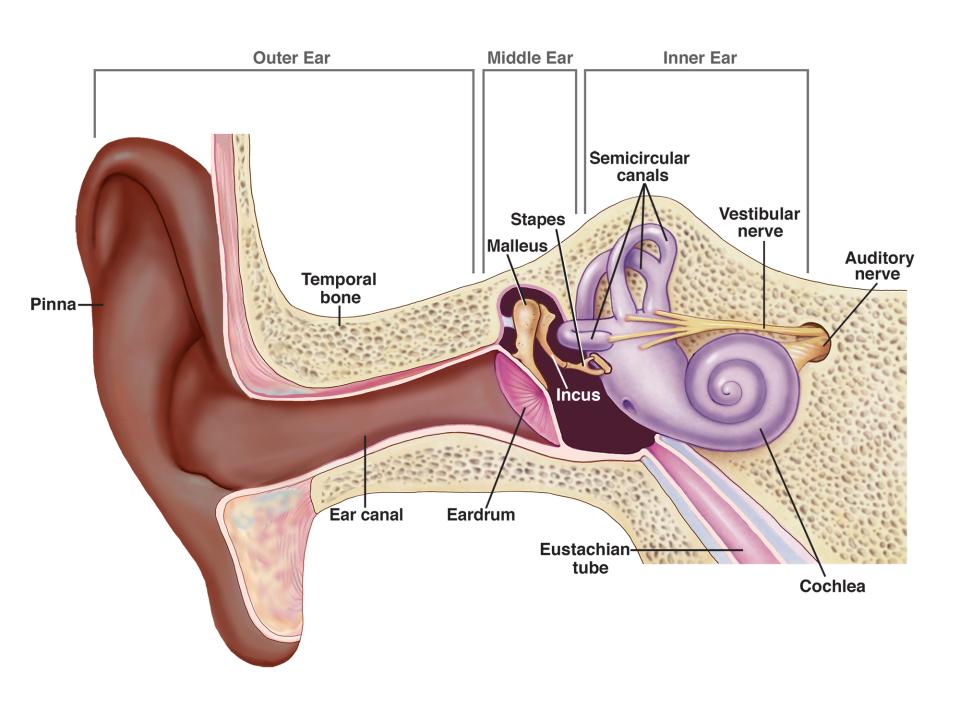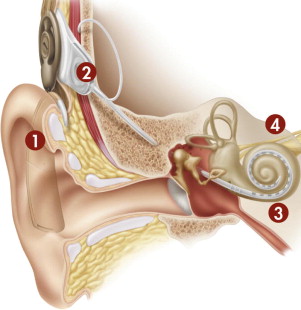Your Child’s Journey: An Ohio Guide for Deaf or Hard of Hearing Support
Hearing Assistive Technology in a Hospital or Clinic Setting
Hearing Assistive Technology (HAT) can provide deaf or hard of hearing children with access to spoken language and sound. An audiologist is qualified to assist you if you are considering HAT. The audiologist may work with an Ear Nose and Throat (ENT) specialist if anything surgical is needed. Audiologists can also work in schools, as well as clinics and hospitals. Below are a range of common HAT devices that may be offered in a hospital or clinic setting.
Hearing Aids
Your child might be a candidate for ![]() hearing aids. A hearing aid is a device that amplifies or enhances your child’s current hearing. A soft ear mold is inserted into the ear, which is connected to a tube. The tube connects to a “sound processor” which has a digital hearing program uploaded onto it. The processor hooks over the ear, the way glasses do. They can be battery or charged powered. Typically, a new hearing aid is needed every five years or so. Ear molds will have to be replaced as your child grows, or if the molds or tubes get damaged. Hearing aids may not be helpful with profound hearing loss.
hearing aids. A hearing aid is a device that amplifies or enhances your child’s current hearing. A soft ear mold is inserted into the ear, which is connected to a tube. The tube connects to a “sound processor” which has a digital hearing program uploaded onto it. The processor hooks over the ear, the way glasses do. They can be battery or charged powered. Typically, a new hearing aid is needed every five years or so. Ear molds will have to be replaced as your child grows, or if the molds or tubes get damaged. Hearing aids may not be helpful with profound hearing loss.
Implants
Surgical implants may be an option for certain hearing conditions. The type of implant depends on the cause and degree of the hearing condition, and whether the inner, middle, or outer ear is affected.
 American Speech-Language-Hearing Association. (n.d.). How we Hear (Diagram). “Retrieved April 21, 2025” https://www.asha.org/public/hearing/How-We-Hear/
American Speech-Language-Hearing Association. (n.d.). How we Hear (Diagram). “Retrieved April 21, 2025” https://www.asha.org/public/hearing/How-We-Hear/
 Bone Conduction Implants (BAHA) These devices send sound through bone conduction, bypassing the outer and middle ear. They require a functioning cochlea to transmit sound to the brain. There is an internal piece, which is surgically implanted, and an external piece, which includes the sound processor.
Bone Conduction Implants (BAHA) These devices send sound through bone conduction, bypassing the outer and middle ear. They require a functioning cochlea to transmit sound to the brain. There is an internal piece, which is surgically implanted, and an external piece, which includes the sound processor. Cochlear Implants bypass the damaged parts of the inner ear and stimulate the auditory nerve directly. A cochlear implant includes two parts, an internal and external piece. The internal piece has a magnet, and an electrode array, which is surgically implanted inside the cochlea. The external piece has a magnet, and a sound processor, which hooks over the ear like a hearing aid.
Cochlear Implants bypass the damaged parts of the inner ear and stimulate the auditory nerve directly. A cochlear implant includes two parts, an internal and external piece. The internal piece has a magnet, and an electrode array, which is surgically implanted inside the cochlea. The external piece has a magnet, and a sound processor, which hooks over the ear like a hearing aid.

(2017, April 1). Cochlear Implantation: Current and Future Device Options (figure image). ENToKey. https://entokey.com/cochlear-implantation-current-and-future-device-options/
 Auditory Brainstem Implants may be an option for children who cannot benefit from other implants, this device stimulates the cochlear nucleus in the brainstem, bypassing the ear entirely.
Auditory Brainstem Implants may be an option for children who cannot benefit from other implants, this device stimulates the cochlear nucleus in the brainstem, bypassing the ear entirely.
Accessories for HAT
Various accessories, like Bluetooth-enabled devices, can enhance the performance of hearing aids and implants. These are useful for connecting to phones, TVs, or in noisy environments like restaurants or classrooms. Talk to your audiologist about options that suit your child’s needs.
 Considerations for Hearing Assistive Technology
Considerations for Hearing Assistive Technology
Watch a mom and her toddler’s experience wearing hearing aids.
Video: Considerations and Tips for Toddlers with Hearing Aids
The audio in this video describes all relevant visual information. Audio description is not needed for this video.
What is Audio Description?
When Audio Description (AD) is enabled, descriptive language narrates what is on the screen. To learn more, visit our accessibility webpage.
Video Player Help
Kaltura Video Hosting: This website uses Kaltura, a video hosting company, to serve video content. If you are having difficulty viewing videos on this site, it may mean that your location (e.g., school district, organization) is blocking or filtering the Kaltura website. Please contact your IT personnel to resolve this issue.
Accessibility: We strive to make this website accessible for all users, including people with disabilities. To learn more visit our accessibility webpage.
Captions / Transcript
After hitting play you can access an interactive transcript for this video by selecting the Show Transcript icon![]() in the top right corner of the video when you select play.
in the top right corner of the video when you select play.
You can turn on captions by selecting the Enable Captions icon![]() in the bottom right corner. Captions can also be turned on by selecting the Settings icon
in the bottom right corner. Captions can also be turned on by selecting the Settings icon![]() , where you can also set your caption preferences.
, where you can also set your caption preferences.
When available, you can use Spanish subtitles for this video by selecting Settings![]() and choosing Spanish in the Captions drop down menu.
and choosing Spanish in the Captions drop down menu.
- Technology can be helpful, but no technology can “cure” deafness.
- Some young children may be reluctant to wear hearing aids or implants. Explore these tip sheets for ideas to support the wearing of HAT.
- People who listen through hearing assistive technology may experience “listening fatigue,” or feel tired from the intense concentration required for listening to and understanding speech.
- HAT requires routine maintenance and appointments with an audiologist. Maintenance includes storing batteries and chargers, using a dehumidifier to extract moisture, and purchasing replacement parts and repairs. The appointments are needed to monitor hearing levels, ensure the devices are still working, and make adjustments for better hearing as needed.
- When a child is deaf/hard of hearing, they often need additional services to learn listening skills and get the most out of their hearing device. Services can include auditory rehabilitation, Auditory Verbal Therapy, or speech therapy. These services may be performed by an audiologist or speech language pathologist.
- Using HAT does not rule out sign language or other communication methods. You can combine communication modes to find what works best for your child. Talk with your child’s audiologist for personalized guidance and support in choosing the best hearing technology and services for your family.